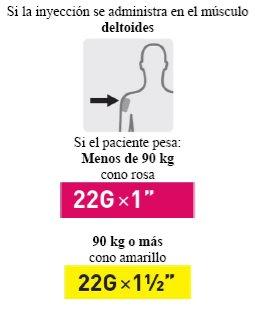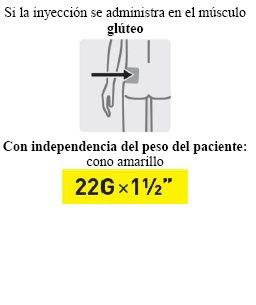
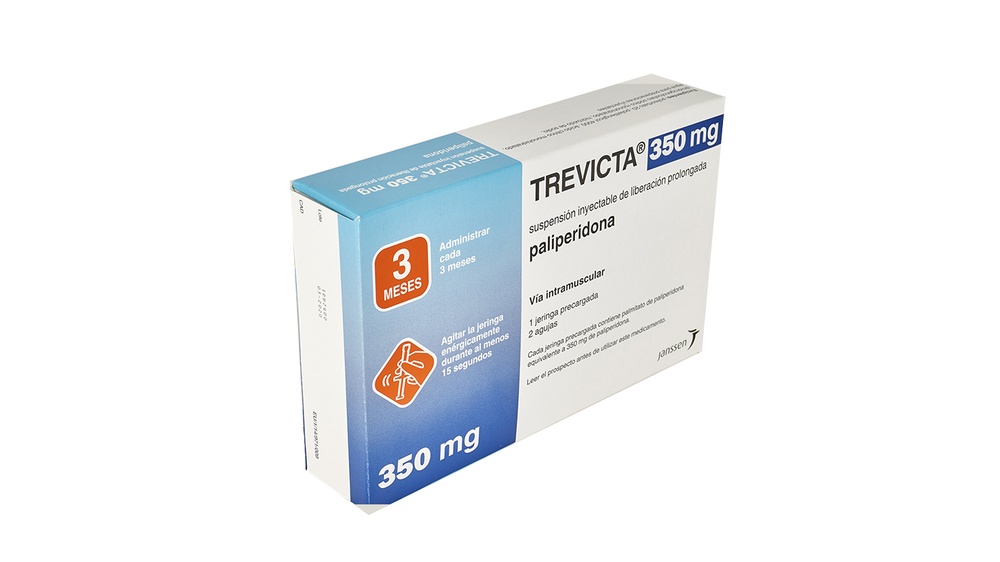
ТРЕВИКТА 350 МГ СУСПЕНЗИЯ ДЛЯ ИНЪЕКЦИЙ ПРОЛОНГИРОВАННОГО ДЕЙСТВИЯ

Спросите врача о рецепте на ТРЕВИКТА 350 МГ СУСПЕНЗИЯ ДЛЯ ИНЪЕКЦИЙ ПРОЛОНГИРОВАННОГО ДЕЙСТВИЯ

Инструкция по применению ТРЕВИКТА 350 МГ СУСПЕНЗИЯ ДЛЯ ИНЪЕКЦИЙ ПРОЛОНГИРОВАННОГО ДЕЙСТВИЯ
Введение
Прошу читать: информация для пользователя
ТРЕВИКТА 175 мг суспензия для инъекций пролонгированного действия
ТРЕВИКТА 263 мг суспензия для инъекций пролонгированного действия
ТРЕВИКТА 350 мг суспензия для инъекций пролонгированного действия
ТРЕВИКТА 525 мг суспензия для инъекций пролонгированного действия
палиперидон
Прочитайте внимательно весь листок перед началом использования этого лекарства, поскольку он содержит важную информацию для вас.
- Сохраните этот листок, поскольку вам может потребоваться перечитать его.
- Если у вас есть какие-либо сомнения, проконсультируйтесь с вашим врачом, фармацевтом или медсестрой.
- Если вы испытываете любой тип побочного эффекта, проконсультируйтесь с вашим врачом, фармацевтом или медсестрой, даже если это возможные побочные эффекты, которые не указаны в этом буклете. См. раздел 4.
Содержание листка
- Что такое ТРЕВИКТА и для чего она используется
- Что вам нужно знать перед началом использования ТРЕВИКТА
- Как использовать ТРЕВИКТА
- Возможные побочные эффекты
- Хранение ТРЕВИКТА
- Содержание упаковки и дополнительная информация
1. Что такое ТРЕВИКТА и для чего она используется
ТРЕВИКТА содержит активное вещество палиперидон, которое относится к классу антипсихотических препаратов и используется в качестве поддерживающего лечения для борьбы с симптомами шизофрении у взрослых пациентов.
Если вы хорошо ответили на лечение палиперидоном инъекционным, вводимым один раз в месяц, ваш врач может решить начать лечение ТРЕВИКТА.
Шизофрения - это расстройство с "позитивными" и "негативными" симптомами. Позитивный означает избыток симптомов, которые обычно не присутствуют. Например, человек с шизофренией может слышать голоса или видеть вещи, которые не существуют (галлюцинации), иметь неправильные убеждения (бред) или иметь чрезмерную подозрительность к другим. Негативный относится к отсутствию поведения или чувств, которые обычно присутствуют. Например, человек с шизофренией может стать замкнутым и не реагировать на какие-либо эмоциональные стимулы или могут иметь проблемы с говорением в ясной и логической форме. Люди, страдающие этим расстройством, также могут чувствовать себя депрессивными, тревожными, виноватыми или напряженными.
ТРЕВИКТА может облегчить симптомы вашего заболевания и уменьшить вероятность их повторного появления.
2. Что вам нужно знать перед началом использования ТРЕВИКТА
Не используйте ТРЕВИКТА
- если вы аллергичны к палиперидону или к любому другому компоненту этого препарата (перечисленному в разделе 6).
- если вы аллергичны к другим антипсихотическим препаратам, включая рисперидон.
Предостережения и меры предосторожности
Проконсультируйтесь с вашим врачом, фармацевтом или медсестрой перед началом использования ТРЕВИКТА.
Этот препарат не был изучен у пожилых пациентов с деменцией. Однако пациенты пожилого возраста с деменцией, которые лечатся другими подобными препаратами, могут иметь повышенный риск инсульта или смерти (см. раздел 4).
Все препараты имеют побочные эффекты, и некоторые из побочных эффектов этого препарата могут ухудшить симптомы других заболеваний. Поэтому важно обсудить с вашим врачом любое из следующих заболеваний, которые могут ухудшиться во время лечения этим препаратом.
- если у вас есть болезнь Паркинсона
- если вам был поставлен диагноз заболевания, симптомы которого включают повышенную температуру и мышечную ригидность (известное как нейролептический мальниантный синдром)
- если у вас были спазмы или неконтролируемые движения лица, языка или других частей тела (тардивная дискинезия)
- если у вас были низкие показатели лейкоцитов (которые могли быть вызваны другими препаратами или нет)
- если вы диабетик или имеете склонность к диабету
- если у вас был рак молочной железы или опухоль гипофиза (гLAND в мозге)
- если у вас есть сердечно-сосудистое заболевание или если вы получаете лечение сердечно-сосудистых заболеваний, которые могут сделать вас более склонным к снижению артериального давления
- если у вас низкое артериальное давление при вставании или если вы чувствуете себя внезапно
- если у вас есть история судорог
- если у вас есть проблемы с почками
- если у вас есть проблемы с печенью
- если у вас есть длительная или болезненная эрекция
- если у вас есть трудности с контролем температуры тела или если вы испытываете чрезмерное потение
- если у вас есть аномально высокий уровень пролактина в крови или если у вас есть возможная опухоль, зависимая от пролактина
- если вы или кто-то из вашей семьи имеет историю тромбозов, поскольку антипсихотики были связаны с образованием тромбов.
Если вы находитесь в одной из этих ситуаций, проконсультируйтесь с вашим врачом, поскольку может потребоваться коррекция дозы или наблюдение за вашим состоянием в течение некоторого времени.
Учитывая, что в редких случаях был обнаружен опасно низкий уровень определенного типа лейкоцитов, ответственных за борьбу с инфекциями в крови у пациентов, получающих этот препарат, врач может решить провести анализ крови.
Даже если вы ранее переносили палиперидон или рисперидон, в редких случаях могут возникать аллергические реакции после введения ТРЕВИКТА. Обратитесь за медицинской помощью немедленно, если вы испытываете кожную сыпь, отек горла, зуд или проблемы с дыханием, поскольку это могут быть признаки тяжелой аллергической реакции.
Этот препарат может вызвать увеличение веса. Значительное увеличение веса может быть вредным для вашего здоровья. Врач будет регулярно контролировать ваш вес.
Учитывая, что был обнаружен диабет или ухудшение существующего диабета у некоторых пациентов, принимавших этот препарат, врач должен наблюдать за возможными признаками гипергликемии. У пациентов с существующим диабетом необходимо регулярно контролировать уровень глюкозы в крови.
Учитывая, что этот препарат может уменьшить рвотный рефлекс, существует возможность того, что он может маскировать нормальную реакцию организма на прием токсичных веществ или других заболеваний.
Во время операции на глазах по поводу катаракты зрачок (круглое отверстие в центре глаза) может не расшириться как необходимо. Кроме того, радужная оболочка (цветная часть глаза) может стать флакцидной во время операции, что может вызвать повреждение глаза. Если вы планируете операцию на глазах, убедитесь, что сообщите своему офтальмологу, что принимаете этот препарат.
Дети и подростки
Не используйте этот препарат у детей и подростков моложе 18 лет. Не известна его безопасность и эффективность у этих пациентов.
Другие препараты и ТРЕВИКТА
Сообщите вашему врачу, если вы принимаете, недавно принимали или можете принимать любой другой препарат.
Если вы принимаете этот препарат с карбамазепином (антиэпилептическим и стабилизатором настроения), может потребоваться коррекция дозы этого препарата.
Учитывая, что этот препарат действует в основном на мозг, использование других препаратов с действием на мозг может усилить побочные эффекты, такие как сонливость или другие эффекты на мозг, такие как другие психиатрические препараты, опиоиды, антигистаминные препараты и снотворные.
Учитывая, что этот препарат может снижать артериальное давление, следует быть осторожным при сочетании его с другими препаратами, снижающими артериальное давление.
Этот препарат может уменьшить эффект препаратов, используемых для лечения болезни Паркинсона и синдрома беспокойных ног (например, леводопы).
Этот препарат может вызвать аномалию электрокардиограммы (ЭКГ), указывающую на то, что электрические импульсы задерживаются в определенной части сердца (известную как "пролонгация интервала QT"). Среди препаратов, оказывающих этот эффект, есть некоторые препараты, используемые для регулирования сердечного ритма или лечения инфекций, а также другие антипсихотики.
Если у вас есть история судорог, этот препарат может увеличить вероятность их повторного появления. Другие препараты, оказывающие этот эффект, включают некоторые препараты, используемые для лечения депрессии или инфекций, а также другие антипсихотики.
ТРЕВИКТА следует использовать с осторожностью с препаратами, увеличивающими активность центральной нервной системы (психостимуляторами, такими как метилфенидат).
ТРЕВИКТА и алкоголь
Алкоголь следует избегать.
Беременность и лактация
Если вы беременны или кормите грудью, считаете, что можете быть беременной или планируете стать беременной, проконсультируйтесь с вашим врачом или фармацевтом перед использованием этого препарата. Не следует использовать этот препарат во время беременности без предварительной консультации с вашим врачом. У новорожденных детей матерей, получавших палиперидон в последнем триместре (три последних месяца беременности), могут появиться следующие симптомы: тремор, ригидность или мышечная слабость, сонливость, агитация, нарушения дыхания и трудности с кормлением. Если ваш ребенок проявляет любой из этих симптомов, обратитесь за медицинской помощью к вашему ребенку.
Этот препарат может проникать от матери к ребенку через грудное молоко и быть вредным для ребенка. По этой причине не следует кормить грудью во время использования этого препарата.
Вождение и использование машин
Во время лечения этим препаратом могут появиться головокружение, чрезмерная усталость и проблемы с зрением (см. раздел 4). Эти эффекты следует учитывать в случаях, когда требуется максимальное внимание, например, при вождении транспортных средств или управлении механизмами.
ТРЕВИКТА содержит натрий
Этот препарат содержит менее 1 ммоль натрия (23 мг) на дозу, что означает, что он практически не содержит натрия.
3. Как использовать ТРЕВИКТА
Этот препарат вводится врачом или медицинским специалистом. Врач укажет, когда необходимо ввести следующую инъекцию. Важно не пропускать назначенную дозу. Если вы не можете посетить врача, убедитесь, что позвоните ему немедленно, чтобы назначить другое время как можно скорее.
Вам будет введена инъекция ТРЕВИКТА в верхнюю часть руки или в ягодицы один раз каждые 3 месяца.
В зависимости от симптомов, которые у вас есть, врач увеличит или уменьшит количество препарата, которое будет введено на следующей запланированной инъекции.
Пациенты с нарушениями функции почек
Если у вас есть легкое нарушение функции почек, врач определит подходящую дозу ТРЕВИКТА на основе дозы палиперидона инъекционного, которую вы получали ежемесячно. Если у вас есть умеренное или тяжелое нарушение функции почек, не следует использовать этот препарат.
Пожилые пациенты
Если у вас снижена функция почек, врач определит подходящую дозу этого препарата.
Если вы получите больше ТРЕВИКТА, чем необходимо
Этот препарат вводится под медицинским наблюдением; поэтому маловероятно, что вы получите больше препарата, чем необходимо.
Если пациент получит чрезмерную дозу палиперидона, он может испытать следующие симптомы: сонливость или седация, тахикардия, гипотония, нарушения электрокардиограммы или медленные и аномальные движения лица, тела, рук или ног.
Если вы прекратите лечение ТРЕВИКТА
Если вы перестанете получать инъекции, симптомы шизофрении могут ухудшиться. Не следует прекращать использование этого препарата без указания врача.
Если у вас есть какие-либо другие вопросы о использовании этого продукта, проконсультируйтесь с вашим врачом или фармацевтом.
4. Возможные побочные эффекты
Как и все лекарства, это лекарство может вызывать побочные эффекты, хотя не все люди их испытывают.
Немедленно сообщите врачу, если:
- у вас образуются тромбы в венах, особенно в ногах (симптомы - отек, боль и покраснение ног), которые через кровеносные сосуды могут добраться до легких, вызывая боль в груди и затруднение дыхания. Если вы заметите любой из этих симптомов, немедленно обратитесь за медицинской консультацией.
- у вас деменция и вы наблюдаете внезапное изменение своего психического состояния или внезапную слабость или онемение лица, рук или ног, особенно с одной стороны тела; или если вам трудно говорить, даже если это происходит в течение короткого времени. Это может быть признаком инсульта.
- у вас появляется лихорадка, мышечная жесткость, пот или снижение уровня сознания (расстройство, называемое "злокачественным нейролептическим синдромом"). Вам может потребоваться немедленное медицинское лечение.
- вы мужчина и у вас出现ляются длительные или болезненные эрекции. Это называется приапизмом. Вам может потребоваться немедленное медицинское лечение.
- у вас появляются ритмичные непроизвольные движения языка, рта и лица. Возможно, потребуется отмена палиперидона.
- вы испытываете тяжелую аллергическую реакцию, характеризующуюся лихорадкой, отеком рта, лица, губ или языка, затруднением дыхания, зудом, кожной сыпью и иногда снижением артериального давления (что представляет собой "анafilактическую реакцию"). Даже если вы ранее переносили пероральный рисперидон или пероральный палиперидон, вы можете редко испытывать аллергические реакции после получения инъекций палиперидона.
- у вас запланирована операция на глазах, убедитесь, что вы сообщите офтальмологу, что принимаете это лекарство. Во время операции на глазах по поводу катаракты возможно, что радужная оболочка (цветная часть глаза) станет слабой во время операции (что называется "синдромом слабой радужной оболочки") с последующим повреждением глаза.
- у вас очень низкое количество определенного типа белых кровяных клеток, необходимых для борьбы с инфекциями крови.
Могут появиться следующие побочные эффекты:
Очень частые побочные эффекты: могут возникать у более чем 1 из 10 человек
- затруднение засыпания или поддержания сна
Частые побочные эффекты: могут возникать у до 1 из 10 человек
- симптомы простуды, инфекции мочевыводящих путей, ощущение гриппа
- TREVICTA может повышать уровень гормона, называемого "пролактином", который обнаруживается в анализах крови (что может вызывать симптомы или нет). Когда появляются симптомы повышения пролактина, они могут включать (у мужчин) отек груди, трудности с эрекцией или другие сексуальные дисфункции; (у женщин) дискомфорт в груди, выделение молока из груди, отсутствие менструаций или другие проблемы с менструальным циклом.
- повышенный уровень сахара в крови, увеличение веса, потеря веса, снижение аппетита
- раздражительность, депрессия, тревога
- чувство беспокойства
- паркинсонизм: это заболевание может включать медленные или измененные движения, ощущение жесткости или скованности мышц (с внезапными движениями) и иногда ощущение "замораживания" движения, которое затем возобновляется. Другие признаки паркинсонизма включают медленную походку, волочение ног, дрожание во время отдыха, увеличение слюноотделения и/или слюнотечение и потерю выражения лица.
- беспокойство, чувство сонливости или снижение внимания
- дистония: это расстройство, включающее медленную или продолжительную непроизвольную сокращение мышц. Хотя любая часть тела может быть поражена (и может вызывать аномальные позы), дистония часто поражает мышцы лица, включая аномальные движения глаз, рта, языка или челюсти.
- головокружение
- дискинезия: это расстройство включает непроизвольные мышечные движения и может включать повторяющиеся, спазматические или скручивающие движения, или спазмы
- дрожание (тремор)
- головная боль
- ускоренная сердечная частота
- артериальная гипертония
- кашель, насморк
- боль в животе, рвота, тошнота, запор, диарея, изжога, зубная боль
- повышение концентрации печеночных трансаминаз в крови
- боль в костях или мышцах, боль в спине, боль в суставах
- отсутствие менструаций, выделение молока из груди
- лихорадка, слабость, усталость (утомление)
- реакции в месте инъекции, с зудом, болью или отеком.
Побочные эффекты, возникающие часто (могут возникать у до 1 из 100 пациентов)
- пневмония, инфекция легких (бронхит), инфекция дыхательных путей, синусит, инфекция мочевого пузыря, инфекция ушей, ангина, инфекция ногтей на ногах, кожные инфекции
- снижение количества белых кровяных клеток, снижение количества определенного типа белых кровяных клеток, помогающих бороться с инфекциями, снижение тромбоцитов (клеток, необходимых для остановки кровотечений), анемия
- аллергическая реакция
- сахарный диабет или ухудшение диабета, повышение уровня инсулина в крови (гормона, регулирующего уровень сахара в крови)
- повышение аппетита
- потеря аппетита, приводящая к недоеданию и снижению веса
- триглицериды (тип жира) высоки в крови, повышение уровня холестерина в крови
- расстройства сна, эйфория (мания), снижение сексуального влечения, нервозность, кошмары
- дискинезия, возникающая поздно (спазмы или непроизвольные движения, которые нельзя контролировать в лице, языке или других частях тела). Сообщите врачу немедленно, если вы испытываете ритмичные непроизвольные движения языка, рта или лица. Возможно, потребуется отмена этого лекарства.
- обморок, сильное желание двигать определенными частями тела, головокружение при вставании, проблемы с вниманием, расстройства речи, потеря или изменение вкуса, снижение чувствительности кожи к боли и прикосновению, ощущение онемения, покалывания или жжения кожи
- размытое зрение, глазная инфекция или покраснение глаз
- ощущение, что все кружится (вертиго), звон в ушах, боль в ушах
- нарушение проводимости между верхними и нижними частями сердца, расстройства сердечной проводимости, удлинение интервала QT сердца, ускорение сердечных сокращений при вставании, замедление сердечной частоты, аномалии на электрокардиограмме (ЭКГ), ощущение сердцебиения или перебоев в груди (сердцебиение)
- низкое артериальное давление, гипотония при вставании (из-за этого эффекта некоторые люди, лечащиеся этим лекарством, могут чувствовать слабость или головокружение или могут обморочиться, когда встают или садятся внезапно)
- затруднение дыхания, конгестия дыхательных путей, одышка, боль в горле, носовое кровотечение
- боль в животе, желудочно-кишечная инфекция, затруднение глотания, сухость во рту, избыточное газообразование или метеоризм
- повышение ГГТ (печеночной ферменты, называемой гамма-глутамилтрансферазой) в крови, повышение печеночных ферментов в крови
- появление волдырей (или крапивницы), зуд, сыпь, выпадение волос, экзема, сухость кожи, покраснение кожи, акне
- повышение КФК (креатинфосфокиназы) в крови, ферменты, которая иногда выделяется при разрушении мышц
- мышечные спазмы, скованность суставов, мышечная слабость, боль в шее
- недержание мочи, частое мочеиспускание, боль при мочеиспускании
- эректильная дисфункция, расстройства эякуляции, отсутствие менструаций или нарушения менструального цикла (у женщин), развитие молочных желез у мужчин, сексуальная дисфункция, боль в груди
- отек лица, рта, глаз или губ, отек тела, рук или ног
- повышение температуры тела
- изменения походки
- боль или дискомфорт в груди, ощущение общего недомогания
- уплотнение кожи
- падения.
Редкие побочные эффекты: могут возникать у до 1 из 1000 пациентов
- глазная инфекция
- воспаление кожи, вызванное клещами, абсцесс под кожей
- повышение эозинофилов (типа белых кровяных клеток) в крови
- неправильное выделение гормона, контролирующего объем мочи
- присутствие сахара в моче
- осложнения неконтролируемого диабета, угрожающие жизни
- снижение сахара в крови
- чрезмерное потребление воды
- спутанность сознания
- отсутствие движения или реакции при бодрствовании (кататония)
- сомнамбулизм
- отсутствие эмоций
- неспособность достичь оргазма
- злокачественный нейролептический синдром (спутанность, снижение или потеря сознания, высокая лихорадка и тяжелая мышечная жесткость), проблемы с кровеносными сосудами мозга, включая внезапную потерю кровоснабжения мозга (инсульт или "мини"-инсульт), отсутствие реакции на стимулы, потеря сознания, снижение уровня сознания, судороги (эпилептические приступы), расстройство равновесия
- анормальная координация
- глаукома (повышение внутриглазного давления)
- нарушения движений глаз, "белые глаза", повышенная чувствительность глаз к свету, слезотечение, покраснение глаз
- фибрилляция предсердий (нарушение сердечного ритма), нерегулярные сердечные сокращения
- тромбы в венах, особенно в ногах (симптомы включают отек, боль и покраснение ноги). Если вы испытываете любой из этих симптомов, немедленно обратитесь за медицинской помощью.
- краснота
- затруднение дыхания во время сна (апноэ во сне)
- легочная конгестия
- хрипы в легких
- воспаление поджелудочной железы, отек языка, недержание кала, выделение очень твердого кала
- трещины на губах
- кожная сыпь, связанная с лекарством, утолщение кожи, перхоть
- отек суставов
- неспособность мочиться
- грудной дискомфорт, отек молочных желез, увеличение размера груди
- вагинальный дисчардж
- очень низкая температура тела, озноб, чувство жажды
- симптомы отмены лекарства
- накопление мертвых клеток в коже вокруг места инъекции, язва в месте инъекции.
Неизвестная частота: не может быть оценена из доступных данных
- очень низкое количество определенного типа белых кровяных клеток, необходимых для борьбы с инфекциями
- тяжелая аллергическая реакция, характеризующаяся лихорадкой, отеком рта, лица, губ или языка, затруднением дыхания, зудом, кожной сыпью и иногда снижением артериального давления
- чрезмерное потребление воды
- расстройство питания, связанное со сном
- кома, вызванная неконтролируемым диабетом
- потрясение головой
- тромбы в легких, вызывающие боль в груди и затруднение дыхания. Если вы испытываете любой из этих симптомов, немедленно обратитесь за медицинской помощью.
- поверхностное и частое дыхание, пневмония, вызванная аспирацией пищи, нарушения голоса
- снижение уровня кислорода в частях тела (из-за снижения кровотока)
- интестинальная обструкция, отсутствие движения кишечника, вызывающее интестинальную обструкцию
- желтый цвет кожи и глаз (желтуха)
- тяжелая аллергическая реакция с отеком, который может повлиять на горло и вызвать затруднение дыхания
- обесцвечивание кожи, шелушение, зуд кожи или кожи головы
- анормальная поза
- новорожденные, матери которых принимали TREVICTA во время беременности, могут испытывать побочные эффекты лекарства и/или симптомы отмены, такие как раздражительность, медленные или продолжительные мышечные сокращения, тремор, бессонница, проблемы с дыханием или кормлением
- приапизм (длительная эрекция, которая может потребовать хирургического лечения)
- снижение температуры тела
- накопление мертвых клеток в коже вокруг места инъекции, язва в месте инъекции.
Уведомление о побочных эффектах
Если вы испытываете любой побочный эффект, проконсультируйтесь с врачом, фармацевтом или медсестрой, даже если это возможные побочные эффекты, которые не перечислены в этом описании. Вы также можете сообщить об этом напрямую через национальную систему уведомления, включенную в Приложение V. Сообщая о побочных эффектах, вы можете способствовать предоставлению более полной информации о безопасности этого лекарства.
5. Хранение TREVICTA
Храните это лекарство в недоступном для детей месте.
Не используйте это лекарство после истечения срока годности, указанного на упаковке. Срок годности - последний день месяца, указанного.
Это лекарство не требует специальных условий хранения.
Лекарства не следует выбрасывать в канализацию или мусор. Спросите у фармацевта, как утилизировать упаковку и лекарства, которые вам больше не нужны. Таким образом, вы поможете защитить окружающую среду.
6. Содержимое упаковки и дополнительная информация
Состав ТРЕВИКТА
Активное вещество - палиперидон.
Каждая предзагруженная шприц-инъектор ТРЕВИКТА 175 мг содержит 273 мг палиперидон-палмитата.
Каждая предзагруженная шприц-инъектор ТРЕВИКТА 263 мг содержит 410 мг палиперидон-палмитата.
Каждая предзагруженная шприц-инъектор ТРЕВИКТА 350 мг содержит 546 мг палиперидон-палмитата.
Каждая предзагруженная шприц-инъектор ТРЕВИКТА 525 мг содержит 819 мг палиперидон-палмитата.
Другие компоненты:
Полисорбат 20
Полиэтиленгликоль 4000
Цитриновая кислота моногидрат
Моногидрат дигидрогенфосфата натрия
Гидроксид натрия (для коррекции pH)
Вода для инъекций
Внешний вид продукта и содержимое упаковки
ТРЕВИКТА - это инъекционная суспензия с длительным действием, белого или почти белого цвета, представленная в предзагруженной шприц-инъекторе, которую врач или медсестра должны энергично встряхнуть для гомогенизации суспензии перед введением.
Каждая упаковка содержит 1 предзагруженную шприц-инъектор и 2 иглы.
Возможно, будут продаваться только некоторые размеры упаковок.
Владелец разрешения на маркетинг
Janssen-Cilag International NV
Turnhoutseweg 30
B-2340 Beerse
Бельгия
Ответственный за производство
Janssen Pharmaceutica NV
Turnhoutseweg 30
B-2340 Beerse
Бельгия
Вы можете запросить дополнительную информацию о этом лекарстве, обратившись к местному представителю владельца разрешения на маркетинг.
Бельгия/Белгique/Бельгия Janssen-Cilag NV Тел/Тель: +32 14 64 94 11 | Литва UAB “JOHNSON & JOHNSON” Тел: +370 5 278 68 88 |
Болгария ”Джонсон энд Джонсон” ЕООД Тел: +359 2 489 94 00 | Люксембург/Люксбург Janssen-Cilag NV Тель/Тел: +32 14 64 94 11 |
Чехия Janssen-Cilag s.r.o. Тел: +420 227 012 227 | Венгрия Janssen-Cilag Kft. Тел: +36 1 884 2858 |
Дания Janssen-Cilag A/S Тльф: +45 45 94 82 82 | Мальта AM MANGION LTD. Тел: +356 2397 6000 |
Германия Janssen-Cilag GmbH Тел: +49 2137-955-955 | Нидерланды Janssen-Cilag B.V. Тел: +31 76 711 1111 |
Эстония UAB “JOHNSON & JOHNSON” Эстонское представительство Тел: +372 617 7410 | Норвегия Janssen-Cilag AS Тльф: +47 24 12 65 00 |
Греция Janssen-Cilag Φαρμακευτικ? Α.Ε.Β.Ε Тηλ: +30 210 80 90 000 | Австрия Janssen-Cilag Pharma GmbH Тел: +43 1 610 300 |
Испания Janssen-Cilag, S.A. Тел: +34 91 722 81 00 | Польша Janssen-Cilag Polska Sp. z o.o. Тел: +48 22 237 60 00 |
Франция Janssen-Cilag Тел: 0 800 25 50 75 / +33 1 55 00 40 03 | Португалия Janssen-Cilag Farmacêutica, Lda. Тел: +351 214 368 600 |
Хорватия Johnson & Johnson S.E. d.o.o. Тел: +385 1 6610 700 | Румыния Johnson & Johnson România SRL Тел: +40 21 207 1800 |
Ирландия Janssen Sciences Ireland UC Тел: +353 1 800 709 122 | Словения Johnson & Johnson d.o.o. Тел: +386 1 401 18 00 |
Исландия Janssen-Cilag AB C/o Vistor hf Сими: +354 535 7000 | Словакия Johnson & Johnson s.r.o. Тел: +421 232 408 400 |
Италия Janssen-Cilag SpA Тел: +39 02 2510 1 | Финляндия Janssen-Cilag Oy Пух/Тел: +358 207 531 300 |
Кипр Βαρν?βας Χατζηπαναγ?ς Λτδ Τηλ: +357 22 207 700 | Швеция Janssen-Cilag AB Тел: +46 8 626 50 00 |
Латвия UAB “JOHNSON & JOHNSON” филиал Латвия Тел: +371 6789 3561 | Великобритания Janssen-Cilag Ltd. Тел: +44 1 494 567 444 |
Дата последнего пересмотра этой инструкции:
Подробная информация о этом лекарстве доступна на сайте Европейского агентства по лекарственным средствам: http://www.ema.europa.eu/.
Информация, предназначенная только для медицинских работников
Эта информация предназначена только для медицинских работников, которые должны прочитать ее вместе с полной информацией о назначении (Резюме характеристик продукта).
| Применять каждые 3 месяца |
| Встряхнуть шприц энергично не менее 15 секунд |
Только для внутримышечного введения. Невводить никаким другим способом.
Важно
Прочитайте полные инструкции перед использованием продукта. Чтобы обеспечить правильное введение ТРЕВИКТА, необходимо внимательно прочитать эти инструкции.
ТРЕВИКТА должен быть введен медицинским работником как однократная инъекция. НЕделить дозу на повторные инъекции.
ТРЕВИКТА показан только для внутримышечного введения. Вводить медленно и глубоко в мышцу, избегая введения в кровеносный сосуд.
Дозировка
ТРЕВИКТА вводится один раз каждые 3 месяца.
Подготовка
Отделите этикетку от шприца и прикрепите ее к медицинской карте пациента.
ТРЕВИКТА требует более энергичной и длительнойвстряски, чем ежемесячный палиперидон-палмитат. Встряхните шприц энергично, держа его вверх, не менее 15 секунд за 5 минут до введения(см. шаг 2).
Выбор иглы с тонкой стенкой
Иглы с тонкой стенкой предназначены для использования с ТРЕВИКТА. Важно использовать только иглы, поставляемые в упаковке ТРЕВИКТА.
Содержимое упаковки на одну дозу


Выбор иглы определяется местом введения и весом пациента.
|
|


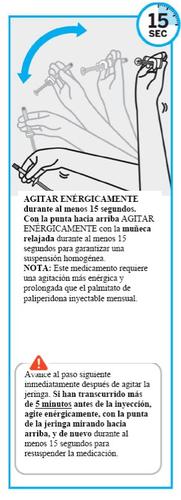
Проверьте суспензию
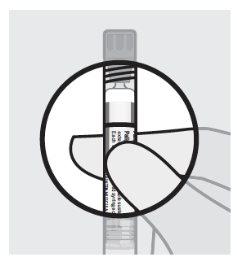
После встряски шприца не менее 15 секунд, проверьте вид суспензии в окне осмотра.
Суспензия должна иметь однородный вид и белый молочный цвет.
Нормально, если появляются небольшие пузырьки воздуха.
Откройте блистер иглы и удалите крышку.
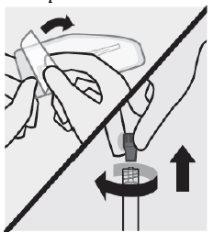
Сначала откройте блистер иглы, отсоединив половину крышки. Опирайтесь на чистую поверхность.
Затем, держа шприц вверх, поверните крышку в сторону, чтобы удалить ее.
Держите блистер иглы.
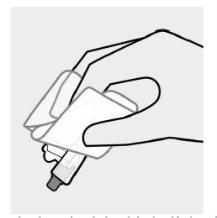
Отогните назад ламину, покрывающую иглу и пластиковую лодку. Затем крепко возьмите чехол иглы за блистер, как показано.
Присоедините иглу

Другой рукой держите шприц за соединение луэра и присоедините к нему иглу безопасности с легким поворотом по часовой стрелке.
Не удаляйтеблистер, пока шприц и игла не будут идеально соединены.
Удалите колпачок иглы
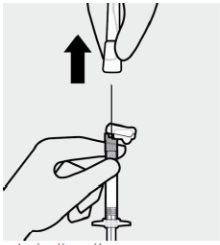
Удалите колпачок иглы, потянув его прямо.
Неповорачивайте колпачок, так как это может ослабить иглу на шприце.
Удалите пузырьки воздуха
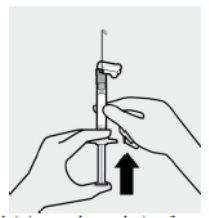
Несколько раз постучите по шприцу, держа его вверх, чтобы пузырьки воздуха поднялись.
Медленно и осторожно нажмите на поршень, чтобы удалить воздух.

Ввести дозу
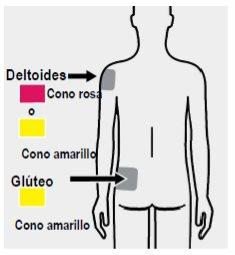
Медленно вводите весь содержимое шприцавнутримышечно, глубоко в дельтовидную или ягодичную мышцу.
Не вводить никаким другим способом.

Защитите иглу
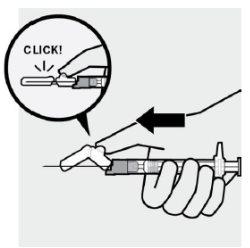
После инъекции используйте большой палец или плоскую поверхность, чтобы активировать механизм безопасности иглы. Игла будет защищена, когда вы услышите «щелчок».
Правильная утилизация
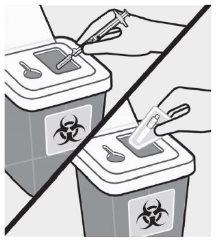
Утилизируйте шприц и иглу в контейнер, одобренный для острых предметов.


Сколько стоит ТРЕВИКТА 350 МГ СУСПЕНЗИЯ ДЛЯ ИНЪЕКЦИЙ ПРОЛОНГИРОВАННОГО ДЕЙСТВИЯ в Испании в 2025 году?
Средняя цена на ТРЕВИКТА 350 МГ СУСПЕНЗИЯ ДЛЯ ИНЪЕКЦИЙ ПРОЛОНГИРОВАННОГО ДЕЙСТВИЯ в декабрь, 2025 года составляет около 560.29 евро. Финальная стоимость может зависеть от региона, конкретной аптеки и рецептурного статуса. Для точной информации лучше проверить онлайн или в ближайшей аптеке.
- Страна регистрации
- Средняя цена в аптеках560.29 EUR
- Активное вещество
- Требуется рецептДа
- Производитель
- Информация носит справочный характер и не является медицинской рекомендацией. Перед приемом любых препаратов проконсультируйтесь с врачом. Oladoctor не несет ответственности за медицинские решения, принятые на основе этого контента.
- Аналоги ТРЕВИКТА 350 МГ СУСПЕНЗИЯ ДЛЯ ИНЪЕКЦИЙ ПРОЛОНГИРОВАННОГО ДЕЙСТВИЯФорма выпуска: ИНЪЕКЦИОННЫЙ РАСТВОР, 150 мг + 100 мгАктивное вещество: paliperidoneПроизводитель: Teva Pharma S.L.U.Требуется рецептФорма выпуска: ИНЪЕКЦИОННЫЙ РАСТВОР, 50 мгАктивное вещество: paliperidoneПроизводитель: Teva Pharma S.L.U.Требуется рецептФорма выпуска: ИНЪЕКЦИОННЫЙ РАСТВОР, 1000 мгАктивное вещество: paliperidoneПроизводитель: Janssen-Cilag International N.VТребуется рецепт
Аналоги ТРЕВИКТА 350 МГ СУСПЕНЗИЯ ДЛЯ ИНЪЕКЦИЙ ПРОЛОНГИРОВАННОГО ДЕЙСТВИЯ в других странах
Лучшие аналоги с тем же действующим веществом и терапевтическим эффектом.
Аналог ТРЕВИКТА 350 МГ СУСПЕНЗИЯ ДЛЯ ИНЪЕКЦИЙ ПРОЛОНГИРОВАННОГО ДЕЙСТВИЯ в Polonia
Аналог ТРЕВИКТА 350 МГ СУСПЕНЗИЯ ДЛЯ ИНЪЕКЦИЙ ПРОЛОНГИРОВАННОГО ДЕЙСТВИЯ в Ucrania
Врачи онлайн по ТРЕВИКТА 350 МГ СУСПЕНЗИЯ ДЛЯ ИНЪЕКЦИЙ ПРОЛОНГИРОВАННОГО ДЕЙСТВИЯ
Консультация по дозировке, побочным эффектам, взаимодействиям, противопоказаниям и продлению рецепта на ТРЕВИКТА 350 МГ СУСПЕНЗИЯ ДЛЯ ИНЪЕКЦИЙ ПРОЛОНГИРОВАННОГО ДЕЙСТВИЯ – по решению врача и с учетом местных правил.






